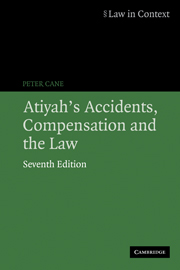Book contents
- Frontmatter
- Contents
- Preface
- List of abbreviations
- List of tables
- Table of legislation
- Table of cases
- Part One The Issues in Perspective
- Part Two The Tort System in Theory
- 2 Fault as a basis of liability
- 3 The scope of the tort of negligence
- 4 Departures from the fault principle
- 5 Causation and remoteness of damage
- 6 Damages for personal injury and death
- 7 An appraisal of the fault principle
- Part Three The Tort System in Operation
- Part Four Other Compensation Systems
- Part Five The Overall Picture
- Part Six The Future
- Index
3 - The scope of the tort of negligence
Published online by Cambridge University Press: 05 June 2012
- Frontmatter
- Contents
- Preface
- List of abbreviations
- List of tables
- Table of legislation
- Table of cases
- Part One The Issues in Perspective
- Part Two The Tort System in Theory
- 2 Fault as a basis of liability
- 3 The scope of the tort of negligence
- 4 Departures from the fault principle
- 5 Causation and remoteness of damage
- 6 Damages for personal injury and death
- 7 An appraisal of the fault principle
- Part Three The Tort System in Operation
- Part Four Other Compensation Systems
- Part Five The Overall Picture
- Part Six The Future
- Index
Summary
The nature of the duty of care
The concept of negligent conduct, which was discussed in chapter 2, together with the notions of causation and remoteness of damage (which are discussed in ch. 5), may be said to constitute the concept of fault as embodied in the tort of negligence. But not all faulty conduct in this sense gives rise to legal liability. The tort of negligence, it is sometimes said, cannot be committed ‘in the air’. A person will be liable for negligent conduct only if that person owed the claimant a duty to take care. In the famous case of Donoghue v Stevenson Lord Atkin enunciated the equally famous ‘neighbour principle’ according to which a duty of care is owed to persons whom you ought reasonably to foresee as likely to be injured if you do not take reasonable care. On the basis of this principle it was, for many years, said that the test of duty of care was foreseeability. However, in the 1980s the House of Lords became dissatisfied with this test, especially in relation to cases involving liability for economic loss; and in a series of cases it developed a threefold test for the imposition of a duty of care: first, was it foreseeable that the claimant might suffer damage if the defendant did not take reasonable care? Secondly, was there a sufficient relationship of proximity between the claimant and the defendant? And, thirdly, is it just and reasonable in all the circumstances of the case to impose a duty of care.
- Type
- Chapter
- Information
- Atiyah's Accidents, Compensation and the Law , pp. 68 - 91Publisher: Cambridge University PressPrint publication year: 2006

